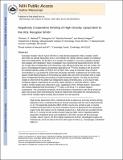Negatively Cooperative Binding of High-Density Lipoprotein to the HDL Receptor SR-BI
Author(s)
Xu, Shangzhe; Krieger, Monty; Nieland, Thomas J.; Penman, Marsha L.
Downloadnihms277637-1.pdf (354.8Kb)
PUBLISHER_POLICY
Publisher Policy
Article is made available in accordance with the publisher's policy and may be subject to US copyright law. Please refer to the publisher's site for terms of use.
Terms of use
Metadata
Show full item recordAbstract
Scavenger receptor class B, type I (SR-BI), is a high-density lipoprotein (HDL) receptor, which also binds low-density lipoprotein (LDL), and mediates the cellular selective uptake of cholesteryl esters from lipoproteins. SR-BI also is a coreceptor for hepatitis C virus and a signaling receptor that regulates cell metabolism. Many investigators have reported that lipoproteins bind to SR-BI via a single class of independent (not interacting), high-affinity binding sites (one site model). We have reinvestigated the ligand concentration dependence of [superscript 125]I-HDL binding to SR-BI and SR-BI-mediated specific uptake of [[superscript 3]H]CE from [[superscript 3]H]CE-HDL using an expanded range of ligand concentrations (<1 μg of protein/mL, lower than previously reported). Scatchard and nonlinear least-squares model fitting analyses of the binding and uptake data were both inconsistent with a single class of independent binding sites binding univalent lipoprotein ligands. The data are best fit by models in which SR-BI has either two independent classes of binding sites or one class of sites exhibiting negative cooperativity due to either classic allostery or ensemble effects (“lattice model”). Similar results were observed for LDL. Application of the “infinite dilution” dissociation rate method established that the binding of [superscript 125]I-HDL to SR-BI at 4 °C exhibits negative cooperativity. The unexpected complexity of the interactions of lipoproteins with SR-BI should be taken into account when interpreting the results of experiments that explore the mechanism(s) by which SR-BI mediates ligand binding, lipid transport, and cell signaling.
Date issued
2011-01Department
Massachusetts Institute of Technology. Department of BiologyJournal
Biochemistry
Publisher
American Chemical Society (ACS)
Citation
Nieland, Thomas J. F., Shangzhe Xu, Marsha Penman, and Monty Krieger. “Negatively Cooperative Binding of High-Density Lipoprotein to the HDL Receptor SR-BI.” Biochemistry 50, no. 11 (March 22, 2011): 1818–1830.
Version: Author's final manuscript
ISSN
0006-2960
1520-4995